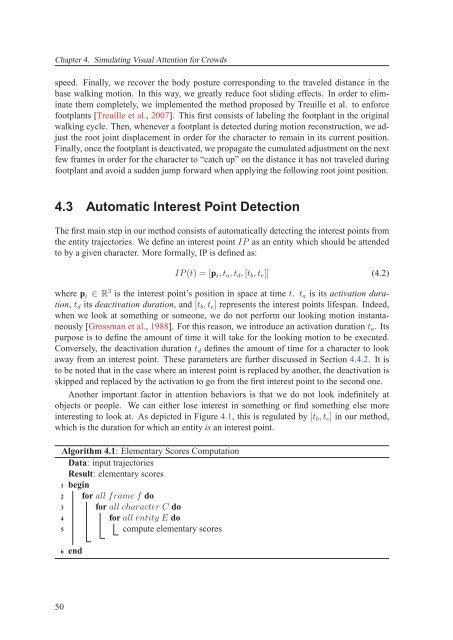Texte intégral / Full text (pdf, 20 MiB) - Infoscience - EPFL
Texte intégral / Full text (pdf, 20 MiB) - Infoscience - EPFL
Texte intégral / Full text (pdf, 20 MiB) - Infoscience - EPFL
You also want an ePaper? Increase the reach of your titles
YUMPU automatically turns print PDFs into web optimized ePapers that Google loves.
Chapter 4. Simulating Visual Attention for Crowds<br />
speed. Finally, we recover the body posture corresponding to the traveled distance in the<br />
base walking motion. In this way, we greatly reduce foot sliding effects. In order to eliminate<br />
them completely, we implemented the method proposed by Treuille et al. to enforce<br />
footplants [Treuille et al., <strong>20</strong>07]. This first consists of labeling the footplant in the original<br />
walking cycle. Then, whenever a footplant is detected during motion reconstruction, we adjust<br />
the root joint displacement in order for the character to remain in its current position.<br />
Finally, once the footplant is deactivated, we propagate the cumulated adjustment on the next<br />
few frames in order for the character to “catch up” on the distance it has not traveled during<br />
footplant and avoid a sudden jump forward when applying the following root joint position.<br />
4.3 Automatic Interest Point Detection<br />
The first main step in our method consists of automatically detecting the interest points from<br />
the entity trajectories. We define an interest point IP as an entity which should be attended<br />
to by a given character. More formally, IP is defined as:<br />
IP(t) =[p t,ta,td, [tb,te]] (4.2)<br />
where pt ∈ R3 is the interest point’s position in space at time t. ta is its activation duration,<br />
td its deactivation duration, and [tb,te] represents the interest points lifespan. Indeed,<br />
when we look at something or someone, we do not perform our looking motion instantaneously<br />
[Grossman et al., 1988]. For this reason, we introduce an activation duration ta. Its<br />
purpose is to define the amount of time it will take for the looking motion to be executed.<br />
Conversely, the deactivation duration td defines the amount of time for a character to look<br />
away from an interest point. These parameters are further discussed in Section 4.4.2. Itis<br />
to be noted that in the case where an interest point is replaced by another, the deactivation is<br />
skipped and replaced by the activation to go from the first interest point to the second one.<br />
Another important factor in attention behaviors is that we do not look indefinitely at<br />
objects or people. We can either lose interest in something or find something else more<br />
interesting to look at. As depicted in Figure 4.1, this is regulated by [tb,te] in our method,<br />
which is the duration for which an entity is an interest point.<br />
Algorithm 4.1: Elementary Scores Computation<br />
Data: input trajectories<br />
Result: elementary scores<br />
1 begin<br />
2 for all frame f do<br />
3 for all character C do<br />
4 for all entity E do<br />
5<br />
compute elementary scores<br />
6<br />
50<br />
end

















